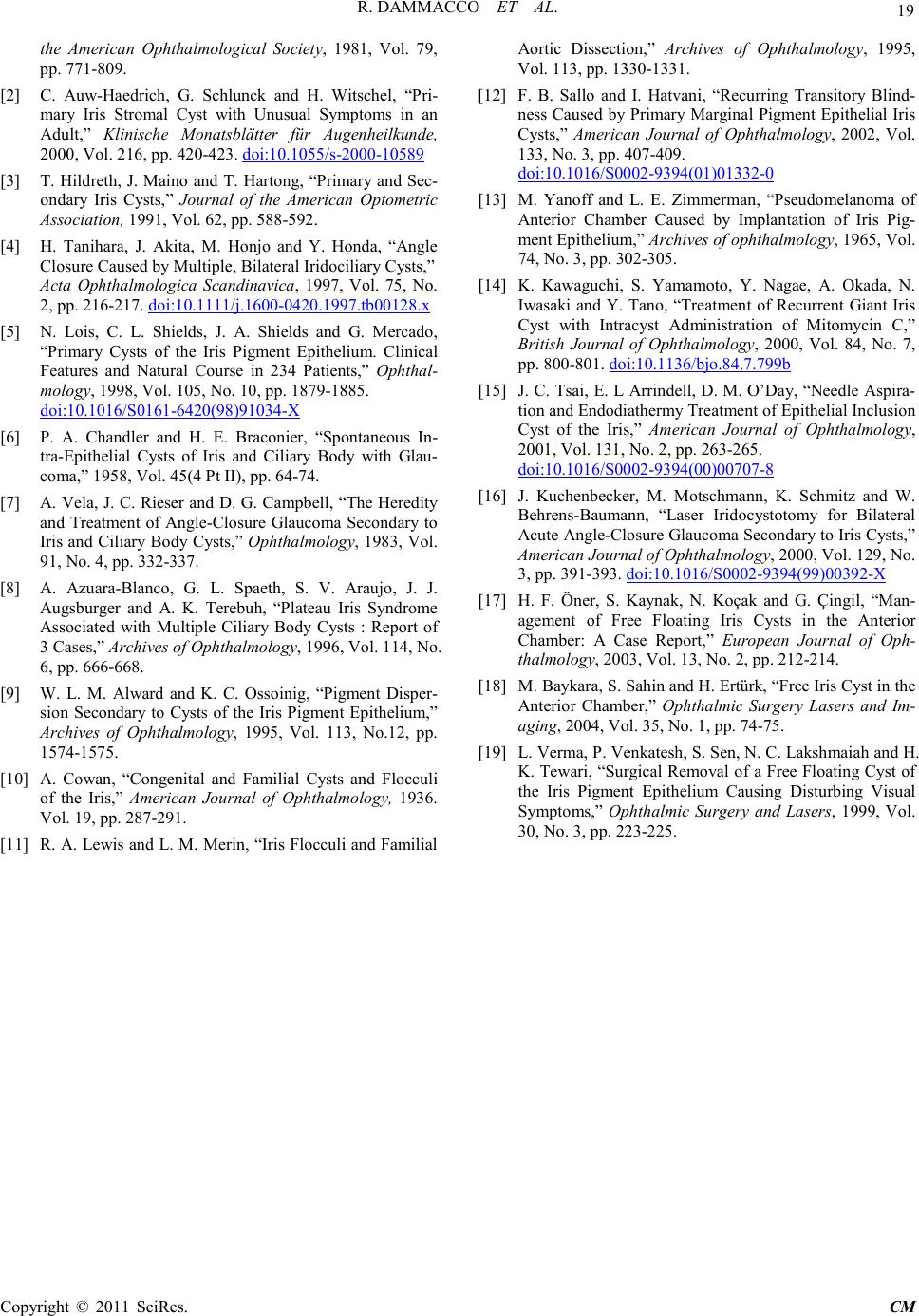
R. DAMMACC O ET AL.
Copyright © 2011 SciRes . CM
the American Ophthalmological Society, 1981, Vol. 79,
pp. 771-809.
[2] C. Auw-Haedrich, G. Schlunck and H. Witsch el, “Pri-
mary Iris Stromal Cyst with Unusual Symptoms in an
Adult,” Klinische Monatsblätter für Augenheilkunde,
2000, Vol. 216, pp. 420-423. doi:10.1055/s-2000-10589
[3] T. Hildreth, J. Maino and T. Hartong, “Primary and Sec-
ondary Iris Cysts,” Journal of the American Optometric
Association, 1991, Vol. 62, pp. 588-592.
[4] H. Tanihara, J. Akita, M. Honjo and Y. Honda, “Angle
Closure Caused by Multiple, Bilateral Iridociliary Cysts,”
Acta Ophthalmologica Scandinavica, 1997, Vol. 75, No.
2, pp. 216-217. doi:10.1111/j.1600-0420.1997.tb00128.x
[5] N. Lois, C. L. Shields, J. A. Shields and G. Mercado,
“Primary Cysts of the Iris Pigment Epithelium. Clinical
Features and Natural Course in 234 Patients,” Ophthal-
mology, 1998, Vol. 105, No. 10, pp. 1879-1885.
doi:10.1016/S0161-6420(98)91034-X
[6] P. A. Chandler and H. E. Braconier, “Spontaneous In-
tra-Epithelial Cysts of Iris and Ciliary Body with Glau-
co ma ,” 1958, Vol. 45(4 Pt II), pp. 64-74.
[7] A. Vela, J. C. Rieser an d D. G. Campbell, “The H er edity
and Treatment of Angle-Closure Glaucoma Secondary to
Iris and Ciliary Body Cysts,” Ophthalmology, 1983, Vol.
91, No. 4, pp. 332-337.
[8] A. Azuara-Blanco, G. L. Spaeth, S. V. Araujo, J. J.
Augsburger and A. K. Terebuh, “Plateau Iris Syndrome
Associated with Multiple Ciliary Body Cysts : Report of
3 Cases,” Arch ives of Ophthalmology, 1996, Vol. 114, No.
6, pp. 666-668.
[9] W. L. M. Al war d and K. C. Ossoi nig, “Pigment Disp er-
sion Secondary to Cysts of the Iris Pigment Epithelium,”
Archives of Ophthalmology, 1995, Vol. 113, No.12, pp.
1574-1575.
[10] A. C owa n , “Congenital and Familial Cysts and Flocculi
of the Iris,” American Journal of Ophthalmology, 1936.
Vol. 19, pp. 287-291.
[11] R. A. Le wi s and L. M. Merin, “Iris Flocculi and Familial
Aortic Dissection,” Archives of Ophthalmology, 1995,
Vol. 113, pp. 1330-1331.
[12] F. B. Sallo and I. Hatvani, “Recurring Transitory Blind-
ness Cau sed by Primary Marginal Pigment Epithelial Iris
C ys t s ,” American Journal of Ophthalmology, 2002, Vol.
133, No. 3, pp. 407-409.
doi:10.1016/S0002-9394(01)01332-0
[13] M. Yan off and L. E. Z immerman, “Pseudomelanoma of
Anterior Chamber Caused by Implantation of Iris Pig-
ment Epithelium,” Archives of ophthalmology, 1965, Vol.
74, No. 3, pp. 302-305.
[14] K. Kawaguchi, S. Yamamoto, Y. Nagae, A. Okada, N.
Iwa sa ki and Y. Tano, “Treatment of Recurrent Giant Iris
Cyst with Intracyst Administration of Mitomycin C,”
British Journal of Ophthalmology, 2000, Vol. 84, No. 7,
pp. 800-801. doi:10.1136/bjo.84.7.799b
[15] J. C. Tsai, E. L Arrindell, D. M. O’Day, “Needle Asp i ra-
tion and Endodiathermy Treatment of Epithelial Inclusion
Cyst of the Iris,” American Journal of Ophthalmology,
2001, Vol. 131, No. 2, pp . 263-265.
doi:10.1016/S0002-9394(00)00707-8
[16] J. Kuchenbecker, M. Motschmann, K. Schmitz and W.
Behren s -B aumann, “Laser Iridocystotomy for Bilateral
Acu te An gle -Closure Glau coma Seco ndar y to Iris Cysts,”
American Journal of Ophthalmology, 2000, Vol. 129, No.
3, pp. 391-393. doi:10.1016/S0002-9394(99)00392-X
[17] H. F. Öner, S. Kaynak, N. Koçak and G. Çingil, “Man-
agement of Free Floating Iris Cysts in the Anterior
Chamber: A Case Report,” European Journal of Oph-
thalmology, 2003, Vol. 13, No. 2, pp. 212-214.
[18] M. Baykara, S. S ah i n and H. Ertürk, “Free Iris Cyst in the
Anterior Chamber,” Ophthalmic Surgery Lasers and Im-
aging, 2004, Vol. 35, No. 1, pp. 74-75.
[19] L. Verma, P. Venkatesh, S. Sen, N. C. Lakshmaiah and H.
K. Tewari, “Surgical Removal of a Free Floating Cyst of
the Iris Pigment Epithelium Causing Disturbing Visual
Sy mp t o ms ,” Ophthalmic Surgery and Lasers, 1999, Vol.
30, No. 3, pp. 223-225.